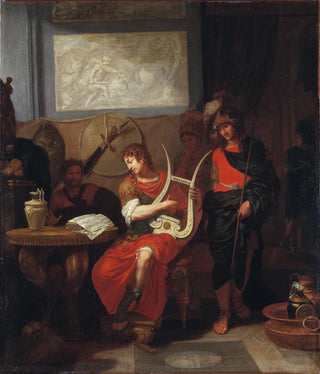Art print | Achilles playing the lyre in front of Patroclus - Gerard de Lairesse


View from behind

Frame (optional)
Achille playing the lyre before Patroclus - Gerard de Lairesse – Captivating Introduction
In the fascinating world of baroque art, "Achille playing the lyre before Patroclus" by Gerard de Lairesse stands out for its ability to capture a moment of intense emotion and beauty. This artwork, which evokes Greek mythology, immerses us in the universe of ancient heroes, where music and friendship intertwine in perfect harmony. The scene depicts Achille, the great warrior, playing the lyre—a representation that symbolizes not only his talent but also his vulnerability in the face of the loss of his friend Patroclus. This art print, faithful to the original, invites us to explore the depths of the human soul through the lens of mythology.
Style and uniqueness of the work
Gerard de Lairesse's style is characterized by fluidity of forms and a rich, luminous color palette. In this piece, the meticulous details of the drapery and the expressions of the characters are highlighted, creating an atmosphere that is both intimate and solemn. Light plays a crucial role, illuminating Achille's face and emphasizing the texture of the lyre, while the darker background accentuates the drama of the scene. The artist manages to convey palpable melancholy, reinforced by Achille's contemplative gaze and Patroclus's resigned posture. This ability to fuse technique and emotion makes Lairesse a master of his time, and this work is a perfect example.
The artist and his influence
Gerard de Lairesse, born in 1640 in the Netherlands, is recognized for his exceptional talent as a painter and art theorist. Influenced by the great masters of painting, he develops a style that combines classicism and baroque, allowing him to stand out in the artistic landscape of the 17th century. His passion for mythology and ancient literature is evident in his works, where he succeeds in bringing epic stories to life with remarkable depth and sensitivity. Lairesse also played an important role in training artists of his time, sharing his knowledge and promoting

Matte finish

View from behind

Frame (optional)
Achille playing the lyre before Patroclus - Gerard de Lairesse – Captivating Introduction
In the fascinating world of baroque art, "Achille playing the lyre before Patroclus" by Gerard de Lairesse stands out for its ability to capture a moment of intense emotion and beauty. This artwork, which evokes Greek mythology, immerses us in the universe of ancient heroes, where music and friendship intertwine in perfect harmony. The scene depicts Achille, the great warrior, playing the lyre—a representation that symbolizes not only his talent but also his vulnerability in the face of the loss of his friend Patroclus. This art print, faithful to the original, invites us to explore the depths of the human soul through the lens of mythology.
Style and uniqueness of the work
Gerard de Lairesse's style is characterized by fluidity of forms and a rich, luminous color palette. In this piece, the meticulous details of the drapery and the expressions of the characters are highlighted, creating an atmosphere that is both intimate and solemn. Light plays a crucial role, illuminating Achille's face and emphasizing the texture of the lyre, while the darker background accentuates the drama of the scene. The artist manages to convey palpable melancholy, reinforced by Achille's contemplative gaze and Patroclus's resigned posture. This ability to fuse technique and emotion makes Lairesse a master of his time, and this work is a perfect example.
The artist and his influence
Gerard de Lairesse, born in 1640 in the Netherlands, is recognized for his exceptional talent as a painter and art theorist. Influenced by the great masters of painting, he develops a style that combines classicism and baroque, allowing him to stand out in the artistic landscape of the 17th century. His passion for mythology and ancient literature is evident in his works, where he succeeds in bringing epic stories to life with remarkable depth and sensitivity. Lairesse also played an important role in training artists of his time, sharing his knowledge and promoting






